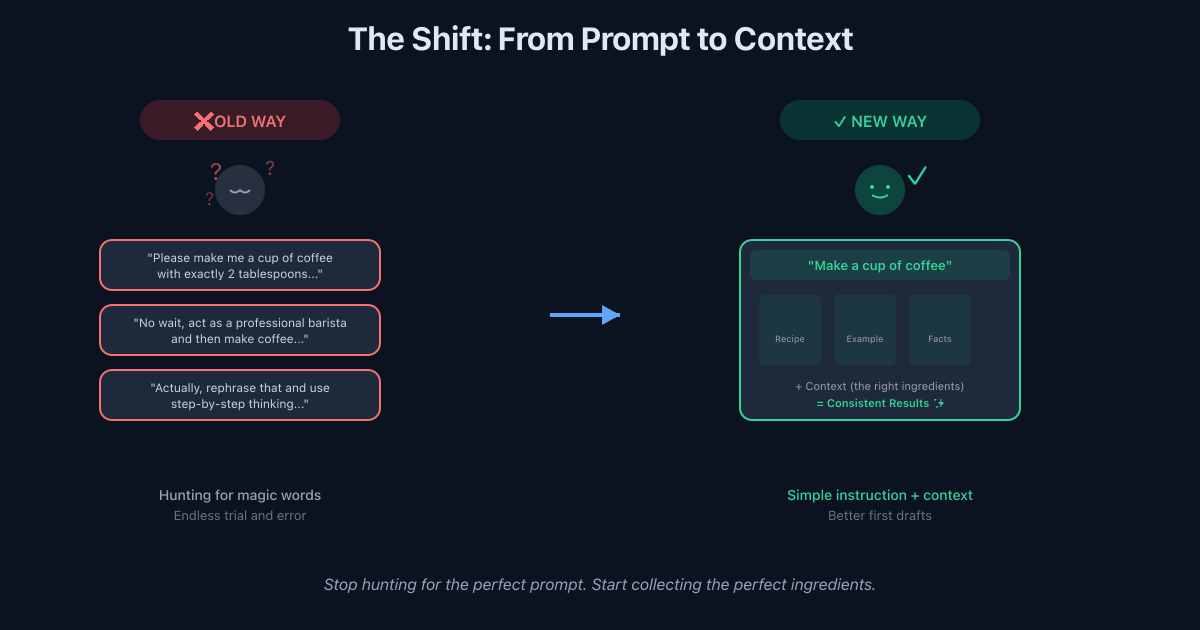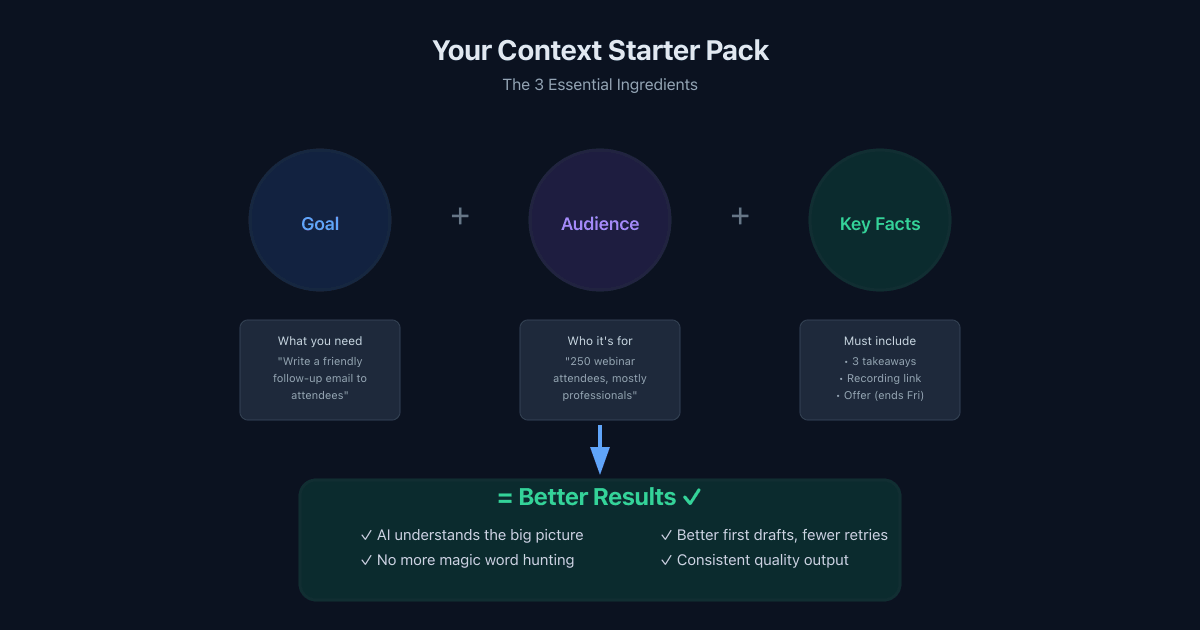From Perfect Prompts to Perfect Ingredients
A few weeks ago I wrote about how my own engineering workflow shifted from prompt phrasing to context-first systems: [https://sidparmar.ca/blog/the-days-of-prompt-engineering-are-over](https://sidparmar.ca/blog/the-days-of-prompt-engineering-are-over).
This follow-up is for non-technical readers.

**Intro:**
Imagine you’re trying to get an AI tool to help you at work or school. In the old days, you had to find just the right way to ask so it wouldn’t get confused. It felt like playing 20 Questions with a robot. A little frustrating, right?
**The Old Way: Prompt Engineering**
We used to rely on “prompt engineering.” You had to phrase every request in a super-specific way. If you changed one word, the answer might change a lot. It’s like giving someone step-by-step instructions for making coffee every single time, instead of just saying, “Can you make a cup of coffee?”
We also had to add *guardrails* into every prompt—telling the AI exactly what **not** to do (“don’t make it sound robotic,” “avoid long paragraphs,” “don’t mention prices”) and what to do instead (“keep it friendly,” “use short bullets,” “make it sound human”). The early models needed constant reminders because they didn’t truly understand tone, limits, or nuance. Every prompt felt like micromanagement—you had to steer it word by word.
**The New Way: Context Engineering**
Now the better approach is “context engineering.” Instead of hunting for magic words, you give the AI the **right background** up front — like a short FAQ, a one-pager, or a screenshot. Think of it like training a new teammate with a quick starter pack: once they have the essentials, they can handle more on their own.
The newest AI models already *understand what not to do*. You don’t have to over-explain or list every possible mistake—they’ve learned from millions of examples what a professional tone or concise answer looks like. All you need to do is set a clear goal and provide the right context, and they’ll handle the rest naturally.
**Why We Don’t Need Step-by-Step Anymore:**
Modern models can absorb more information at once and connect the dots, so they catch the “big picture” when you supply the right ingredients. In practice, that means you can say “make a coffee,” not list every step—**as long as you provide the recipe** (the context). Anthropic calls this *context engineering* and emphasizes that context is a limited resource you should curate carefully so the model has exactly what it needs (and not a lot of fluff). ([Anthropic][1])
**A Simple Analogy:**
If you were teaching someone to bake a cake, you wouldn’t recite the instructions every time. You’d give them the recipe once, let them read it, and they’d know what to do. Context engineering is like giving the AI the recipe so it can do the rest.
**Why It Matters to You:**
Whatever your role — student, coordinator, customer-facing, educator, operations — you don't need to be technical. Just think about the **ingredients** you'd hand to a person to do the job well, and give the same to the AI:
* A short goal ("Write a friendly follow-up email to webinar attendees".)
* Who it's for (the audience).
* The key facts (3 takeaways, the offer and deadline, links).
* One example you like (tone or style) — not always mandatory.

**Try It (quick checklist):**
1. **One-sentence instruction.** State the goal and any must-haves.
2. **Add context, not fluff.** Attach the source (doc/link/screenshot), audience, and one example. Treat context like a budget — include only what helps. ([Anthropic][1])
3. **Keep it tidy.** Short bullets and labels beat walls of text.
4. **Review like an editor.** Ask for one revision if needed (“shorter intro,” “include the date”).
5. **Refresh context.** Update your starter pack when facts change — stale context leads to stale answers. (Improving what gets retrieved into context also helps; Anthropic’s *Contextual Retrieval* shows how better retrieval boosts downstream results.) ([Anthropic][2])
**Want to go deeper?**
* Anthropic — *Effective context engineering for AI agents* (why context is a limited resource and how to curate it well). ([Anthropic][1])
* Anthropic — *Contextual Retrieval in AI Systems* (technique to improve what enters context in the first place). ([Anthropic][2])
**Bottom line:**
Stop hunting for the perfect prompt. Start curating context. Start collecting the **perfect ingredients**.
Short instruction + the right context → better first drafts, fewer retries.
[1]: https://www.anthropic.com/engineering/effective-context-engineering-for-ai-agents?utm_source=chatgpt.com "Effective context engineering for AI agents"
[2]: https://www.anthropic.com/news/contextual-retrieval?utm_source=chatgpt.com "Contextual Retrieval in AI Systems"